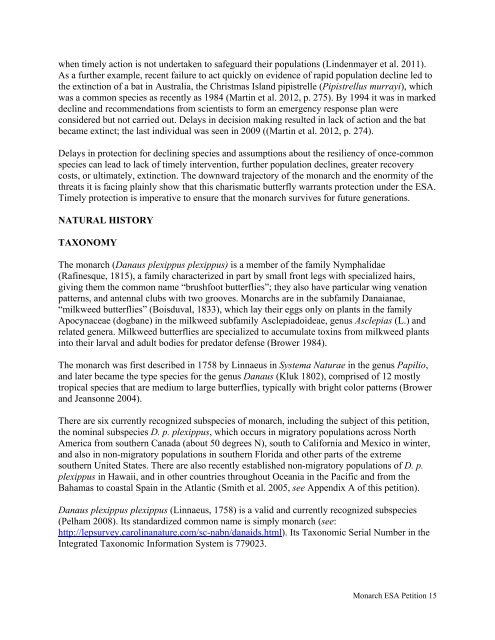monarch-esa-petition-final_61585
monarch-esa-petition-final_61585
monarch-esa-petition-final_61585
You also want an ePaper? Increase the reach of your titles
YUMPU automatically turns print PDFs into web optimized ePapers that Google loves.
when timely action is not undertaken to safeguard their populations (Lindenmayer et al. 2011).<br />
As a further example, recent failure to act quickly on evidence of rapid population decline led to<br />
the extinction of a bat in Australia, the Christmas Island pipistrelle (Pipistrellus murrayi), which<br />
was a common species as recently as 1984 (Martin et al. 2012, p. 275). By 1994 it was in marked<br />
decline and recommendations from scientists to form an emergency response plan were<br />
considered but not carried out. Delays in decision making resulted in lack of action and the bat<br />
became extinct; the last individual was seen in 2009 ((Martin et al. 2012, p. 274).<br />
Delays in protection for declining species and assumptions about the resiliency of once-common<br />
species can lead to lack of timely intervention, further population declines, greater recovery<br />
costs, or ultimately, extinction. The downward trajectory of the <strong>monarch</strong> and the enormity of the<br />
threats it is facing plainly show that this charismatic butterfly warrants protection under the ESA.<br />
Timely protection is imperative to ensure that the <strong>monarch</strong> survives for future generations.<br />
NATURAL HISTORY<br />
TAXONOMY<br />
The <strong>monarch</strong> (Danaus plexippus plexippus) is a member of the family Nymphalidae<br />
(Rafinesque, 1815), a family characterized in part by small front legs with specialized hairs,<br />
giving them the common name “brushfoot butterflies”; they also have particular wing venation<br />
patterns, and antennal clubs with two grooves. Monarchs are in the subfamily Danaianae,<br />
“milkweed butterflies” (Boisduval, 1833), which lay their eggs only on plants in the family<br />
Apocynaceae (dogbane) in the milkweed subfamily Asclepiadoideae, genus Asclepias (L.) and<br />
related genera. Milkweed butterflies are specialized to accumulate toxins from milkweed plants<br />
into their larval and adult bodies for predator defense (Brower 1984).<br />
The <strong>monarch</strong> was first described in 1758 by Linnaeus in Systema Naturae in the genus Papilio,<br />
and later became the type species for the genus Danaus (Kluk 1802), comprised of 12 mostly<br />
tropical species that are medium to large butterflies, typically with bright color patterns (Brower<br />
and Jeansonne 2004).<br />
There are six currently recognized subspecies of <strong>monarch</strong>, including the subject of this <strong>petition</strong>,<br />
the nominal subspecies D. p. plexippus, which occurs in migratory populations across North<br />
America from southern Canada (about 50 degrees N), south to California and Mexico in winter,<br />
and also in non-migratory populations in southern Florida and other parts of the extreme<br />
southern United States. There are also recently established non-migratory populations of D. p.<br />
plexippus in Hawaii, and in other countries throughout Oceania in the Pacific and from the<br />
Bahamas to coastal Spain in the Atlantic (Smith et al. 2005, see Appendix A of this <strong>petition</strong>).<br />
Danaus plexippus plexippus (Linnaeus, 1758) is a valid and currently recognized subspecies<br />
(Pelham 2008). Its standardized common name is simply <strong>monarch</strong> (see:<br />
http://lepsurvey.carolinanature.com/sc-nabn/danaids.html). Its Taxonomic Serial Number in the<br />
Integrated Taxonomic Information System is 779023.<br />
Monarch ESA Petition 15




